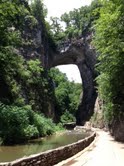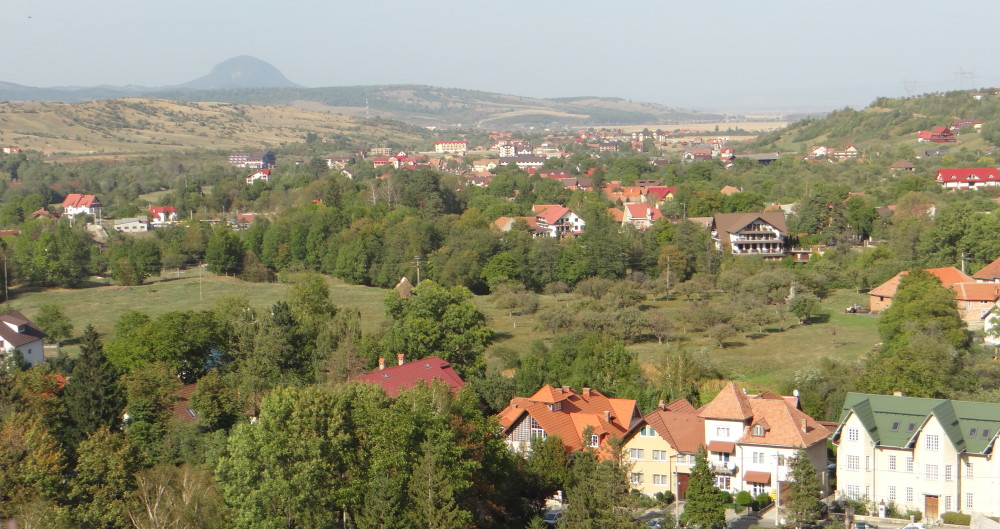 “So beautiful an arch, so elevated, so light, and springing as it were up to heaven, the rapture of the spectator is really indescribable. It is the most sublime of Nature’s works.”
“So beautiful an arch, so elevated, so light, and springing as it were up to heaven, the rapture of the spectator is really indescribable. It is the most sublime of Nature’s works.”
– Thomas Jefferson, Note on the State of Virginia
Walking down 147 steps along a tiny creek cascading gradually to a larger bed, huge rocks surround us on both sides. I wondered in anticipation, where is this Natural Wonder? And suddenly, the view opens and a grey mammoth arch covered with lush green vegetation rises out of the wet and moss-covered rock. Rivulets of water flow on all sides of the limestone, constantly carving.
The 215 ft. high arch is 55 ft. taller than Niagara Falls, 40 ft. thick, 100 ft. wide and spans 90 ft. above the massive walls, a bridge made of Ordovician rock, 500 million years old. The tool was water and the master who carved this masterpiece 1160 ft. above sea level was a simple mountain stream, Cedar Creek.
The Monacan Indians, an eastern Siouan nation, who lived in the area for an estimated 10,000 years called the Natural Bridge, “Mohomony,” “The Bridge of God,” or “Great Mystery.” Monacan men, women, and children, chased by enemies, came upon a big chasm between two large boulders and, faced with impending doom, closed their eyes and prayed. When Monacan warriors opened their eyes, a narrow rock bridge had materialized across the gorge and they were able to fight the chasing enemy crossing the Natural Bridge.
Four centuries ago, Monacans could be found in the western and central parts of Virginia, as “far west as the Falls of Richmond, where John Smith and his Jamestown settlers first made contact with the tribe.” There are still 1,400 Monacans living in Virginia in the Bear Mountain region near Lynchburg.
Nobody claimed the 157-acre close to Glasgow, Virginia, because it was not suitable for agriculture. Following a trail on horseback from Paxson’s Tavern in nearby Glasgow, Thomas Jefferson discovered on August 23, 1767 the massive Natural Bridge. He purchased the land on July 5, 1774 from King George III for the modest sum of $160.
In 1927 a surveyors cross still visible today was found with the initials “GW” on a stone in Cedar Creek. The story goes that George Washington, an athletic teenager, had scaled the south face of the Natural Bridge and carved his initials there.
The teen George Washington was working for Colonel Peter Jackson, Thomas Jefferson’s father, who was surveying the Indian trail, called “Big Path” to measure the boundaries of the 157-acre plot. The representative of the King of England, Lord Fairfax of Cameron, ordered the survey in 1750 in order to build a road between Winchester and Buchanan.
George Washington never mentioned this story in his writings, nor is the survey work formally documented. They are mentioned in written descriptions dating back to 1830s.
Jefferson visited his property during annual “rambles;” there are four records of such visits. A two story stone and log cabin was built in 1803 on the present day location of the Natural Bridge Hotel. Jefferson and his guests would stay in this cabin during his visits, tended by Patrick Henry and his wife Luisa. There was a visitor guest book but was lost in the cabin fire in 1845. According to museum archives, some of the more famous visitors were: James Monroe (fifth President), Andrew Jackson (seventh President), Martin Van Buren (eighth President), John Marshall (fourth Chief Justice), Henry Clay (Kentucky statesman), Daniel Boone (American pioneer and explorer), and Sam Houston (first Governor of Texas).
Jefferson owned the Natural Bridge until his death in 1826, leaving it to his family. He used the caves around the bridge for the production of ammunition during the war. There is plenty of saltpeter (potassium nitrate) in the caves, the essential ingredient for black gun powder (75% potassium nitrate, 15% charcoal, and 10% sulphur). However, in 1816, Jefferson provided a custodian for its natural preservation, leasing the land to Patrick Henry, a man freed from slavery. With his wife Luisa, Patrick Henry farmed 10 acres, watched for vandals and trespassers, took care of Jefferson’s cabin, and cared for Jefferson’s many guests.
John Sallings, who built a cabin and settled in the area after six years of Indian captivity, was “probably the first white man to see the bridge.” From his diary, “Colonel John Buchanan preserved the earliest record of the bridge.” (Museum Archives)
In 1834, the second owner of the bridge, Capt. Lackland, devised a hexagonal iron cage, hoisted up and down by strong men working a hand windlass that carried courageous individuals up to view the bridge from the air for the price of $1 per person.
The subterranean waters have carved caves; some were enlarged by human blasting to the size of caverns and to a passable depth of 350 ft. Long time ago, the bridge was actually the ceiling of a large cavern that had collapsed, resulting in the breathtaking bridge that we see today.
In 1812, workmen who extracted nitrate from the Saltpeter Cave heard the water rumblings of the Lost River. They blasted an opening to allow the Lost River to flow outward. Several attempts to locate the source of the underground water have been made with color dyes and flotation devices, all unsuccessful.
I likened the visually arresting and breathtaking experience of seeing the Natural Bridge for the first time to being mesmerized by the thundering Niagara Falls, another majestic monument built by the power of nature and God. As Dr. Norman Vincent Peale said, it “is something like being in a church. It almost brings tears to your eyes.”
Cedar Creek, originating 180 miles away in the Allegheny Mountains, plunging 50 feet in an elegant plume of white water, the Lace Waterfalls, flows under the Natural Bridge and then joins the James River a mile away. The water seems deceptively calm, lazy, and cool on my bare feet. Rev. Andrew Reed described it so poetically in 1835, “Oh, it is sublime – so strong and yet so elegant – springing from earth and bathing its head in heaven.”
The town of Lexington, just north of the Natural Bridge, was the recruiting area for the southern army during the Civil War. One of the nation’s first tourist attractions, during the Civil War both Union and Confederate officers saw the Natural Bridge and recorded their impressions in letters and public documents.
The bridge was so famous that Confederates detoured from their march after the Battle of Lynchburg to see it. Assistant Surgeon Thomas Fanning Wood of the 3rd North Carolina Infantry wrote in his memoirs, “On the 23rd started on the march towards Lexington, and on the same day I got permission to visit or go by the Natural Bridge. … We had pointed out to us the letters G. Washington carved in the stone, which were once quite plain, but time has nearly effaced the last vestige of them. … The story was that George Washington had climbed this ledge to the top. None of us tried this experiment, but we learned that Henry MacRae [of the regiment] … climbed to a very dangerous point, and finding he could not get to the top, had to be rescued by a rope let down from above.” (Museum Archives)
Some of General David Hunter’s Union troops, after burning down the Virginia Military Institute in Lexington, while marching to Lynchburg, detoured to see and cross the famous Bridge.
“We passed within three miles of the Natural Bridge. Officers were much disappointed by not being able to see it. Lieutenant Meigs and some others did go by that road.” (Museum Archives)
The Natural Bridge was also used as a “shot tower” during the Revolutionary War and the War of 1812. To make a “shot,” molten lead was dropped through a copper sieve high above a pool of water, in this case, the Cedar Creek. Surface tension and the cooling of droplets as they fell created a perfect ball which cooled in the water below. Different size holes in the sieve created different size balls.
Today, the Lee Highway, U.S. Route 11, still crosses over the ultimate natural wonder bridge, painted, drawn, visited, and admired by many, and built by the erosive power of water over millions of years.
